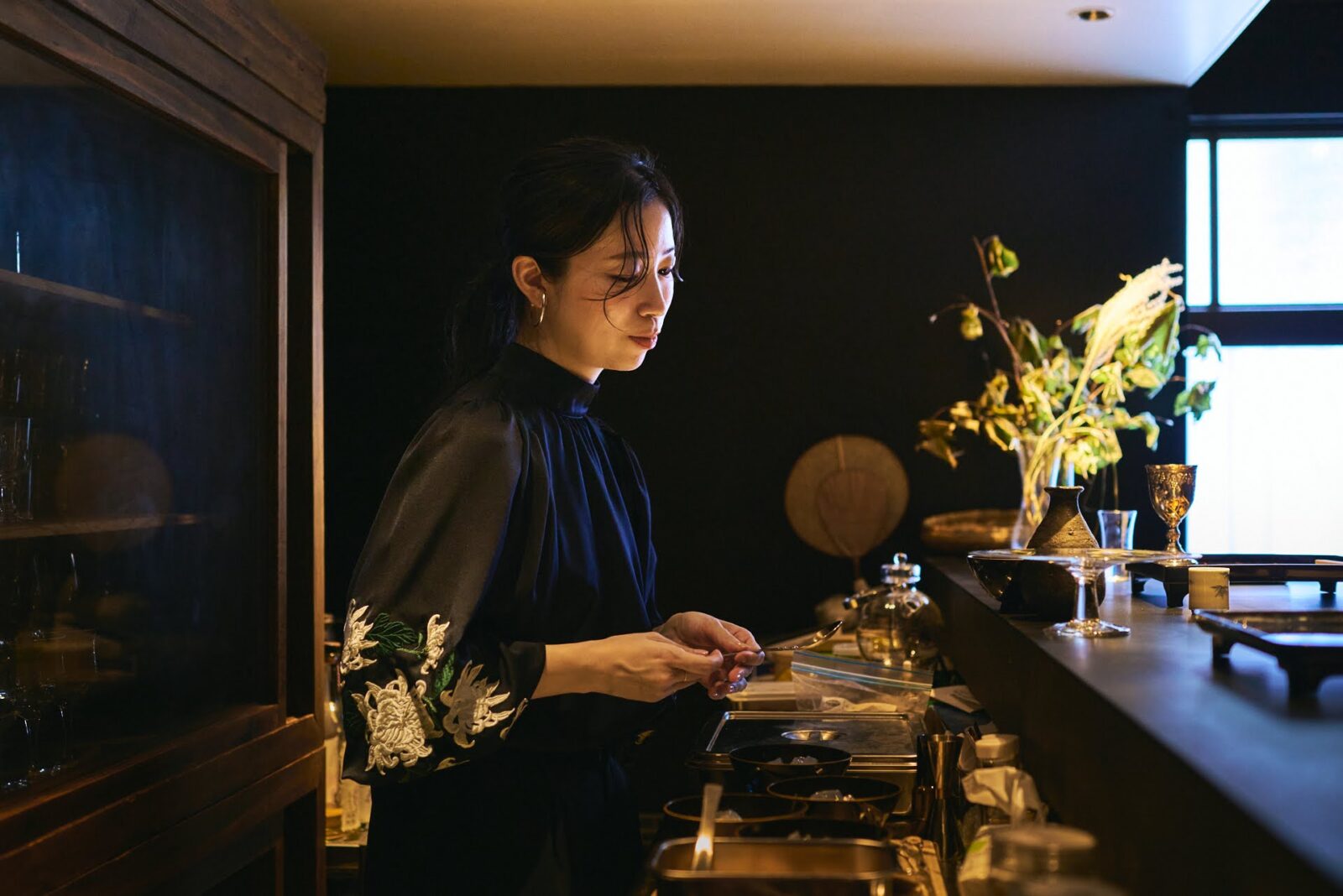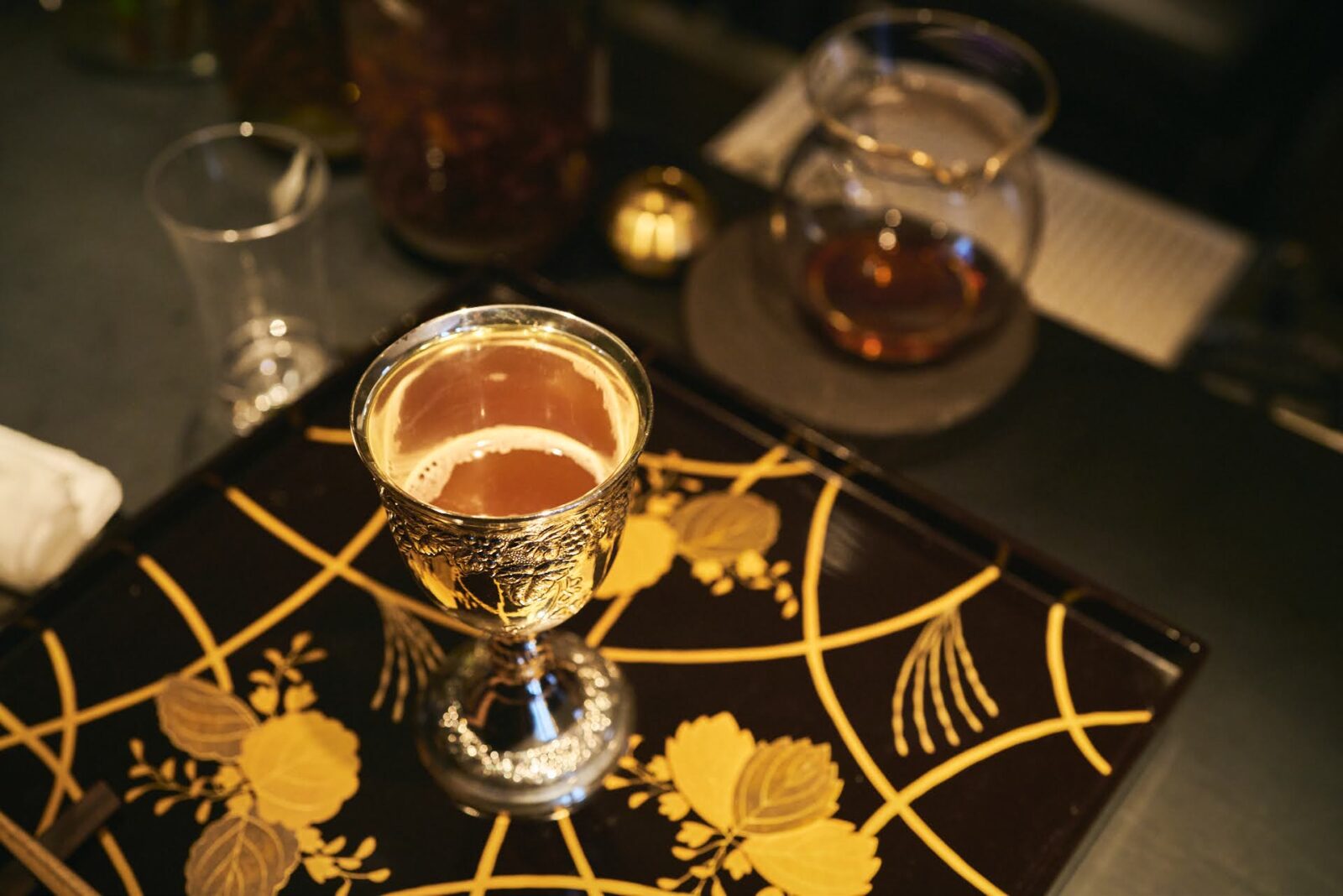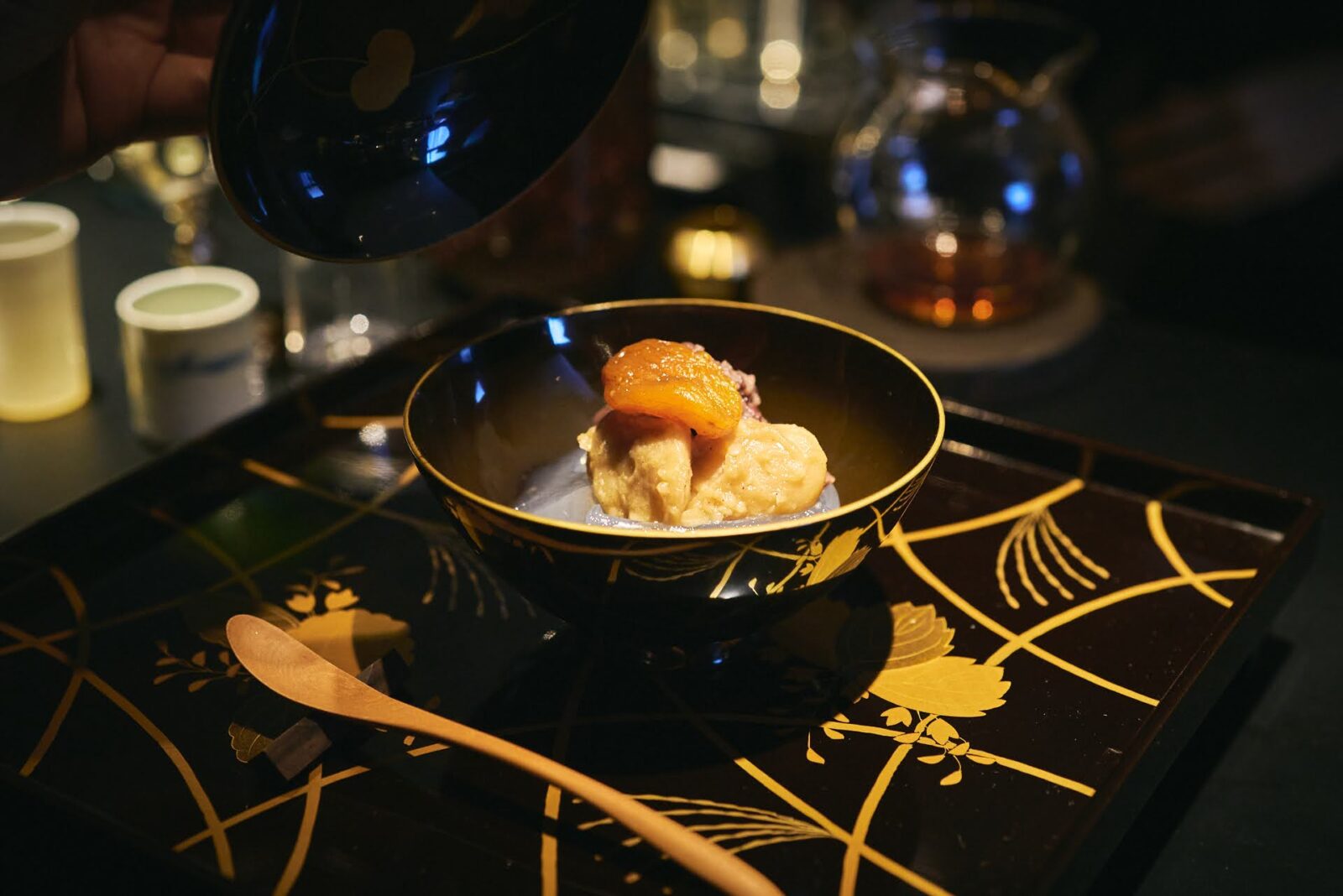In a dimly lit traditional Japanese house, a restaurant is serving a course of non-alcoholic drinks from the middle of the day.
Another unique aspect of this restaurant is the fact either alcohol or tea is chosen as your chaser drink.
The name of the restaurant is -oriori- and it is a reservation only restaurant that is only open a few times a month.
The owner of the restaurant is emmy, a recognized beverage artist in the food and drink industry among chefs and other professionals.
She is a self-taught beverage artist who has produced hundreds of drink recipes and now superives beverage services at other restaurants and events. She combines her original drinks with the elements of space to create new shikohin (luxury) experiences through drinks.
emmy says she loves alcohol and was trained in an authentic bar, so how did she end up in the world of non-alcoholic drinks?
What potential does she see in non-alcoholic drinks as she promotes her creations in events and pop-up stores?
-oriori- is an experimental lab for emmy and we spoke to her as we experienced her non-alcoholic drink course first hand.
Opening at 11 am. The dimly lit bar counter lets you forget the passage of time

The restaurant is located in Hongo of Bunkyo-ku, Tokyo.
-oriori- stands quietly among other wooden buildings in an alley that retains a traditional Japanese downtown atmosphere.
When the pure white entrance curtain is placed at the eaves of the building, it is a sign that the restaurant is open.
-oriori- only opens a few times a month and is reservation only. The building acts as emmy’s non-alcoholic cocktail specialty shop and atelier. Here, her original drinks serve as the main course and they are accompanied by small dishes that are too special to simply call appetizers. The course is also served with chaser drinks.

The restaurant usually opens at 11am or 1:30 pm. The dimly lit counter seats make you forget that it is midday. Not only is the space designed to let you forget the passage of time, the aroma of the herbs and ingredients used in the drinks stimulates the senses and the gentle tone of emmy’s voice all come together to make up the unique atmosphere of -oriori-.

“I used to work as a sales representative for an apparel company for two years after graduating from a fashion college at the age of 20. It was during a time when Japan was transitioning into fast fashion and I was disenchanted by the mass production and mass consumption I witnessed in the industry.”
“Around that time I began to feel a strong desire to work in a way that involved creating spaces for people, rather than consuming materials. I think there are various ways to approach this, such as architecture, however I envisioned a space of communication and expression so I started working in the restaurant industry.”
Why -oriori- is not referred to as a bar
After starting her career in the restaurant industry and having opportunities to work at a bar, emmy was struck by the history, culture and depth of the industry. She looked for a place to gain experience and started working in an authentic bar in Nezu.
“The bar master taught me to experience multiple bars besides his, so I worked there for about 7 years while also working at other bars along the way. I learned a lot in that time. Not only about how to make drinks, but also the art of sophisticated drinking, old-fashioned drinking games using dice, adult luxuries and shikohin experiences and how to hold conversations with customers.”

We were drawn to emmy’s supple and elegant movements when creating drinks, such as how she maneuvered the measuring cup or lightly stirred the drinks.
emmy says she always enjoyed drinking alcohol. When she was first considering opening her own bar, she felt there was a limit to the variety of alcoholic drinks she could offer if she wanted to continue working as an independent drink supervisor and host pop-up stores.
“Since I didn’t have my own shop before, I found it difficult to gather various liquors from around the world in order to make a limited variety of alcoholic drinks. I realized that I could make the base ingredients for nonalcoholic drinks myself and after I learned that I could really make anything, I began developing non-alcoholic drink recipes.”

emmy began posting her original drink recipes on X (formerly Twitter) everyday. She started off with recipes that could be recreated by anyone, but eventually she desired to pursue a higher level of skill and ingredients. Her desire to serve drinks to customers directly also began to grow.

Alcoholic drinks as chasers bring out the full potential of non alcoholic drinks
There are two course menus that are offered at -oriori-.
One course is made up of four non alcoholic cocktails, four plates of food and two chaser drinks. The other course has three non alcoholic cocktails, one plate of food and one chaser drink.
Although the menu changes every month, the short course we experienced in October came with a drink that was based on a kinmokusei (Osmanthus fragrans) tea with grated pear, sudachi citrus and a hint of carbonation.
She tells us that the sweetness of the clear fruity pear juice is emphasized by using rocked sugar. Sweetness is an important factor in nonalcoholic drinks, which tend to lack in body, so she uses different types of sugar, such as rocked or cane sugar, depending on the recipe.

The first plate of food in the short course was an original fruit salad that featured pickled daikon radish. In this season, the salad has persimmons and is flavored with honey, vinegar, herb salt and pepper.
The ripe seasonal persimmons act like a sauce that encompasses the daikon radish, giving it a unique texture.
She also uses vinegar from Vinegar Brewery Shoubunsu, a 300 year old vinegar maker in Okawa City of Fukuoka Prefecture, which has a mild acidity that goes well with the added honey to create a delightful dish.

The chaser drink is served at just the right timing.
The chaser can be chosen from a wide range of teas and alcoholic drinks such as a selection of natural wines, craft beers, and Japanese sake. It is a unique style of serving chaser drinks.

“Although the main attraction is the nonalcoholic drinks, I want to give alcohol a place as both are important to me. By adding a slight presence of alcohol, it opens up your senses to the flavors, scents and atmosphere. I think this allows you to enhance your non alcoholic drink experience as well.”
For the second drink, emmy sprayed the inside of a glass with distilled water made from lemongrass and cypress.
With a base of olive tea from Shodoshima, the drink combines distilled water made from cedar and cypress leaves, black vinegar and a hint of kabosu citrus. It is a drink that is not only fragrant, but also allows you to experience the presence of trees in the glass.

The distilled water made from cedar and cypress leaves are sourced from connections made with people in the forestry industry when she was doing an event in Oita Prefecture.
“They created a brand called Rokugatsu Yohka, which makes aroma oils from trees that are thinned in the forest. When I went to do field work in Nakatsu City of Oita Prefecture they let me work with the trees myself.”
“At that event, they presented a drink with the image of a river flowing from on top of a mountain. The water upstream has a pure scent, while mid-stream has the scent of leaves and life. At the bottom of the stream there is a hint of artificial sweeteners. The drink made me more interested in the cycle of life.”
“When you are living in the city, it is hard to understand that nurturing trees and forests in the mountains are connected to the sea and directly connected to our daily lives. That is why I want to make drinks that use ingredients with meaning.”

To finish off the course and set the tone, the final drink was based on Kyobancha, with a combination of burdock root tea, persimmon and black vinegar.
The earthy flavors of the burdock root and Kyobancha connected in a way that gave the drink a smoky flavor and aroma.

We ordered an additional dessert, which is not a part of the short course menu.
Their popular dessert menu is a hand made anmitsu, a Japanese red bean paste-based dessert. It features agar made from amakusa seaweed, honey made from forest nectar or distilled water from cypress, and red bean paste cooked with ginger, cacao nibs and salt.
On this day, the agar was stewed in lemongrass and had a juicy flavor, with some white flower beans cooked with cardamon on the side. It was a mouthwatering, delicious dish that left flavors lingering in the mouth and was a perfect way to end the course.

Nonalcoholic drinks can be enjoyed by anyone, anywhere and allows for the exploration of creativity and freedom

At least four different cordial like base ingredients are bottled and on hand to use to make the course drinks at -oriori-.
The hundreds of different drink recipes she has created so far include many unexpected combinations and ingredients, such as beets, blueberries and rosemary, or black beans with cacao, mirin with roses, myoga with kimokusei, burdock with persimmon and whiskey distilled water and more.
“When I come up with a recipe, I start with ingredients that are in season, but I don’t only look at fruits. I try to narrow it down to about three ingredients that I think would work well together, and then I start fine tuning the recipe as I experiment and see what I can add to complete it.”

She gets her ingredients at the market, but she also often gets ingredients sent directly from friends who have moved to the countryside. She has a distiller in the restaurant and in addition to distilling various food ingredients, she is also exploring distillation of soil.
“I always imagine and try to build a three dimensional flavor when I am creating non alcoholic drink recipes. Alcohol drinks have body, but that is hard to bring out in non alcoholic drinks so I try to add depth by adding layers of different ingredients.”
All of the drinks she creates, whether it be for other restaurants or her own, is created at -oriori- so the space also serves as her laboratory.
“Since this place is where I conduct experiments on my own, I want to make it a more closed restaurant, or perhaps make it introduction-only or for people I know directly. On the other hand, I want to work with others in areas that I cannot do alone, such as creating drinks for other restaurants, holding pop-up stores and working with other artists and people from different industries to create a hub for non-alcoholic drinks.”
In 2023, emmy opened a pop-up bar in Nishi Ginza Parking Lot for a limited time only. She supervised the creation of non-alcoholic drinks named after the streets of Ginza, such as “Hanatsubaki-dori” and “Namiki-dori”.
At the end of this year she will be holding an event at the natural wine shop Sake Room -Centoux- that also runs a bistro in Kuramae. The theme of the event will be soba (buckwheat) and wll feature food and non-alcoholic drinks.
“I have plans next year to serve drinks at exhibitions that are inspired by the artist’s work. I will also have events in collaboration with chefs and I really feel that the possibilities for non alcoholic drinks are growing.”
“Not only do non alcoholic drinks have the advantage of being able to be enjoyed anywhere by anyone, I think it is a genre that inspires and allows for more exploration of creativity and freedom than coffee or tea does.”

The name 澱々-oriori- includes the word “ori” which can mean the sediment in wine and other drinks, however emmy says that it also expresses the meaning for “changing seasons” and “the combination of various components on top of one another.”
As she layers the various fragrances and flavors of ingredients, emmy enhances her skills. Through collaborations and working with people at events, her ability to express herself also expands. The drinks that are served in this special space create the unique experience at -oriori- which will surely continue to evolve as it pursues an insatiable curiosity.
Translation: Sophia Swanson
After taking a food sensory test during university and discovering a keen sensitivity to “umami”, she traveled for food in and out of Japan for 25 years. While working at a publishing company, she was in charge of the gourmet food section of a fashion magazine. Later, she worked for an informational magazine before becoming independent in 2013. Now she writes articles and has a series on food for online and printed mazagines.
Editor, Writer, etc., for PLANETS, designing, De-Silo, MIMIGURI, and various other media.
